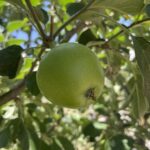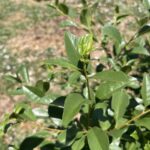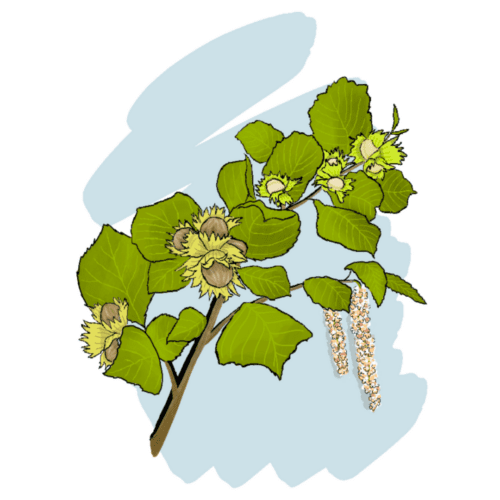Plant Species Signs
Click the images below to learn more!
Click the images below to learn more!

Latin Name: Malus domestica
Region of Origin: Central Asia
Harvest Time: July – October
An adaptable tree that can grow to 35 feet wide and tall on standard rootstock, apples are one of the most widely known and most-used fruits in the world. In the 19th century there were over 14,000 distinct varieties of apples grown in the United States, but even today there are still more than 2,500 in cultivation. Different varieties lend themselves to diverse uses, from fresh eating to pies, vinegar, sauce, and cider. Vulnerable to fireblight and coddling moth.
Plant |
Fruit |

Latin Name: Aronia melanocarpa
Region of Origin: Eastern North America
Harvest Time: September – October
Also called “chokeberry”, aronias have the most antioxidants of any berry. They grow to be a wide-spreading shrub 4-8 feet tall and wide, with deep purple berries and striking red leaves in the fall. Aronia berries are highly astringent until late in the growing season and are best in preserves or syrups, but can be eaten fresh. It is best to harvest all the berries at one time as a crop. They are native to North America but not to Colorado.
Plant |
Leaves |

Latin Name: Pyrus pyrifolia
Region of Origin: Asia
Harvest Time: July – September
A medium-sized tree growing to 25 feet tall on standard rootstock. While less commonly grown in North America, the fruit is crisper than European Pear and much less vulnerable to pests and diseases except for fireblight. Like peaches, they bloom early and must be planted in a place where it stays cooler in the spring to delay bloom time, avoid late frosts, and fruit consistently. Good for fresh eating or preserves; especially delicious when dried.
Plant |
Leaves |

Latin Name: Rubus fruiticosus
Region of Origin: All Temperate Regions
Harvest Time: July – September
Blackberries are native in some form to almost every temperate region on earth, but cultivated blackberries have a long history and are now able to produce heavy fruits on thornless vines like those in DUG food forests. They usually require some kind of trellising to thrive but can grow many feet in one year. Excellent for fresh eating, baking, and preserves.

Latin Name: Rubus ursinus var loganobaccus
Region of Origin: Europe, cultivated
Harvest Time: July – August
A cousin of the blackberry, boysenberries have larger berries and are reddish in color, but have the same vining habit and precocious growth of several feet per year. Usually require some kind of trellising to thrive. Can be eaten fresh or used in baking or preserves.
Plant |
Leaves |

Latin Name: Prunus sect. microcerasus
Region of Origin: Eastern Europe, bred in North America
Harvest Time: July – August
A relatively recent product of selective breeding programs, bush cherries are tart cherries with a bushing habit, growing only 6-8 feet tall and wide as a shrub and bearing earlier than trees. Carrying the cold tolerance and disease resistance of their tree cousins, bush cherries produce fruit that is best for preserves but can also be eaten fresh.
Plant |
Leaves |
Immature Fruit |
Ripe Fruit |

Latin Name: Ribes rubrum, Ribes nigra
Region of Origin: Northern Europe
Harvest Time: June – August
Currants are cold-tolerant shrubs that grow 4-5 feet tall and can thrive in full sun or part shade, producing small pea-sized berries that are good for fresh eating or preserves. Red and white currants are sweeter, while black currants have a piney taste and leaves that smell like pine when rubbed. There are native currants in Colorado like the Wax or Golden Currant that do not bear as heavily as domesticated varieties.
|
Plant |
Leaves |
Immature Fruit |

Latin Name: Sambucus nigra
Region of Origin: Europe
Harvest Time: July – early October
Fast-growing multi-stem shrub that can spread if not managed. Elderberries bloom throughout the season, creating a rolling harvest of dark purple berries. All parts of the plant except the berries are poisonous, and berries need to be cooked to be digested. While there are native North American elderberries, most in DUG food forests are European varieties because they are more medicinal. Berries can be made into tinctures or syrup.
|
Plant |
Leaves |

Latin Name: Pyrus communis
Region of Origin: Europe
Harvest Time: July – October
Medium to large tree, growing up to 30 feet tall on standard rootstocks. European Pears are similar to apples in their diversity and history of cultivation (3000 known varieties), but are less commonly eaten in the United States. Fruit can be harvested early and will ripen off the tree, which is a major advantage against animal predation. Pears are vulnerable to fireblight and can be eaten fresh, or used in preserves and sweet or alcoholic ciders.
|
Plant |
Leaves |
Immature Fruit |

Latin Name: Prunus domestica
Region of Origin: Eastern Europe and Central Asia
Harvest Time: July – early October
Large shrub to medium-sized tree (25 feet wide and tall) that grows quickly and can form thickets if unmanaged. While plums have a long history of cultivation, many of the most delicious varieties are not sold in grocery stores because their soft flesh makes them difficult to transport. Plums are vulnerable to many diseases and pests in humid climates but thrive in Colorado’s climate and are good for fresh eating, preserves, or wine.
|
Plant |
Leaves |
Immature Fruit |

Latin Name: Ribes uva-crispa
Region of Origin: Europe and Western Asia
Harvest Time: July – August
Exceptionally cold-tolerant shrubs that grow 4-5 feet tall and can thrive in full sun or part shade. While similar in growth habit to currants, gooseberries are thorny and produce larger marble-sized berries that are delicious and satisfying for fresh eating or for baking or preserves. The thorns make them difficult to harvest but also reduce predation from non-human animals.

Latin Name: Corylus avellana, Corylus spp.
Region of Origin: Western Europe
Harvest Time: August – October
One of the only nut trees that can produce consistently in the Front Range, hazelnuts can grow as a multi-stem shrub or a medium-sized tree around 12-15 feet tall. The hazelnuts in DUG food forests are selected varieties grown to be more productive and resistant to Eastern Filbert Blight. Hazelnuts are an excellent source of healthy fats and protein and can be eaten fresh or processed into preserves once the nuts are freed from the dry brown shell.
|
Plant |
Leaves |

Latin Name: Lonicera caerulea
Region of Origin: Northern North America, Europe, and Asia
Harvest Time: June – August
Also called “haskap”, “fly honeysuckle”, and many other names, honeyberries are native to much of the northern part of the world but selected varieties are useful for increased fruit production. A low-growing shrub to 3 or 4 feet, honeyberries tolerate extreme cold and produce oblong blue berries early in the season that are good for fresh eating. They do not tolerate full Colorado sun well, so they thrive underneath other established plants or in a shady place.

Latin Name: Ribes × nidigrolaria
Region of Origin: Europe
Harvest Time: June – August
Cold-tolerant berry plant that grows 4-5 feet tall and can thrive in full sun or part shade. Jostaberries are a complex cross between black currant and gooseberry; they retain much of the size of gooseberry fruit but are thornless like currants. Especially good for baking and preserves.

Latin Name: Ziziphus jujuba
Region of Origin: Northern China
Harvest Time: July – August
Also known as “red date” or “Chinese date”, jujubes are a highly nutritious and medicinal food from a region with a similar climate to Colorado. Thorny early growth gives way to a highly drought-, disease-, and pest-resistant tree up to 20 feet tall that thrives in full sun and hot conditions. Jujubes are only recently hardy in Front Range winters, so they are an experiment in climate adaptation.
Leaves


Latin Name: Morus rubra
Region of Origin: Middle-East, Asia, Africa, North America
Harvest Time: June – September
In evolutionary terms mulberries are much older than most other fruit trees, and some types can grow 40-50 feet tall. They bloom and fruit throughout the season, so they are resistant to late frosts. Birds love them, and they are difficult to store, so the fruit is better used in preserves if not eaten fresh. The leaves are edible, and other species of mulberry are the main food source for silk worms.

Latin Name: Prunus persica
Region of Origin: China
Harvest Time: July – September
Growing 15 to 25 feet, peach trees have reddish-orange new growth and are shorter-lived than other fruit trees. Peaches are drought- and heat-tolerant, but their branches can break easily. Although peaches are an iconic Colorado fruit, they are vulnerable to late frosts on the Front Range and must be planted in a cooler place to fruit consistently. Susceptible to gummosis and peach borer, peaches are good for fresh eating and preserves.
|
Plant |
Leaves |
Immature Fruit |

Latin Name: Diospyros virginiana x kaki
Region of Origin: Asia and North America
Harvest Time: September – October
The only kind of persimmon currently planted in DUG food forests is the “Nikita’s Gift” hybrid of the American and Asian persimmon. It retains much of the size and taste of the Asian varieties with the cold tolerance of the native American species, which grows much larger and produces smaller fruit. Depending on the time of harvest, the skin can be astringent while the flesh is sweet. Fruits will ripen off the tree but should be picked as late as possible.

Latin Name: Amelanchier alnifolia
Region of Origin: North America
Harvest Time: June – July
Colorado’s version of the blueberry, serviceberry is also known as “saskatoon” and “juneberry”. Wild plants grow along streams and rivers, but domesticated varieties produce more heavily. Tolerant of a wide variety of conditions, serviceberries are loved by birds and wildlife and are delicious for fresh eating as well as in preserves. They are often used as landscaping plants in Colorado, but make sure you are certain of identification before eating.

Latin Name: Prunus cerasus
Region of Origin: Eastern Europe
Harvest Time: July – August
A smaller tree growing 10-20 feet tall, tart cherries are more cold-tolerant than sweet cherries and play a large cultural role in Eastern Europe. Also known as “sour” or “pie” cherries, they bear early in the season and, because of their increased acidity, are better used for preserves and baking than fresh eating. Cherries are less vulnerable to disease and pests than many other fruit trees in Colorado.
|
Plant |
Leaves |
|
Immature Fruit |
Ripe Fruit |